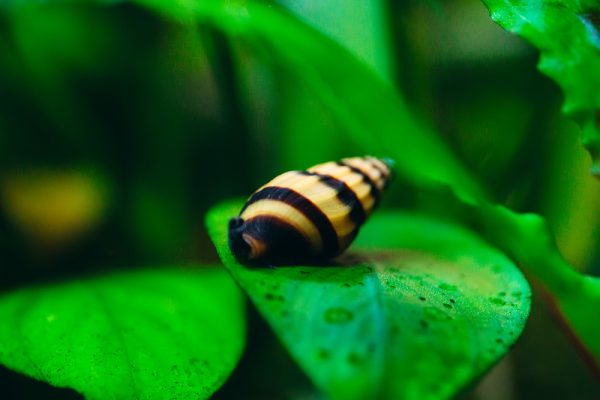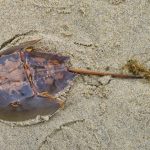Snails are a type of mollusk that can be found both in land and aquatic ecosystems. Snails are hermaphrodites, i.e., they have both male and female sexual organs. It is well known that some species of snails get into hibernation during the winter season, while others remain active all year round. it is a common concept that snails don’t hibernate.

They are becoming very popular for home aquariums. Not only do they offer a different look to fish, but snails are one of the Land snails that typically hibernate in the colder months, while some types of snails may estivate (undergo a period of dormancy) when their environment becomes too hot or dry.
However, it is important to note that not all types of snails get into hibernation or estivate; some species remain active all year long. For example, aquarium snails do not typically go through any kind of hibernation cycle and remain active throughout the year.
In conclusion, while some snails may hibernate or estivate depending on their environment and species, other snails may remain active all year round.
Why Do Snails Hibernate?
Snails are a type of mollusk, and like other animals, they need to hibernate during the winter months. Land snails get into hibernation when temperatures drop too low or when the ground freezes. Aquatic snails also hibernate due to different environmental conditions.
Snails can also hibernate in response to prolonged dry periods. During this time, the snail hasn’t moved, and become inactive and its metabolic rate slows down drastically, conserving energy and moisture within its body.
Hibernation is a very important part of a snail’s life cycle, as it allows them to conserve energy throughout the colder months of the year and prepare for warmer weather ahead.
Do Mystery Snails Hibernate?
Mystery snails are a type of freshwater snail that is popular in aquariums. Many snails, including mystery snails, will go through a period of hibernation in colder temperatures. During this time, the snail would slow down its metabolism and stop eating while it conserves energy.
This period of hibernation can last for months depending on the temperature and other environmental factors. Snails to go into hibernation when the water temperature drops below 15 degrees Celsius or 59 degrees Fahrenheit. In general, snails have a tendency to remain inactive for a long period of time.
How To Tell If A Snail Is Dead, Sleeping, Or Hibernating?
- You can guess in different ways if a snail is sleeping or dead. Snails usually sleep during the day since most species are active at night. The sleeping snail can appear dead.
- Examine the water snail shell carefully. If the body of the snail is no longer inside the shell or if the snail hangs out of the shell and does not move, then the snail has died. When a snail is dead, its suctioning body, which sticks to the surface, ceases to stick. So, whenever you check whether your snail is dead or sleeping, you need to see if the snails stick to the glass of the aquarium or not.
- Hold the snail shell in front of a light source such as a flashlight. Look at the heartbeat to determine if the snail remains alive. You can only see the heartbeat in young and thin-shelled snails. This can also cause the snail to retract in its shell, indicating that it’s alive.
- If the snail is sticking its head out of its shell, but doesn’t seem to be moving much and appears to be in a deep sleep, then it’s probably just sleeping. If the body of the snail is no longer inside the cell or if the snail hangs out of the shell and does not move, then the snail has died.
- If the shell of the snail has completely retracted and isn’t responding to stimuli, then it may be hibernating as this is a common practice for snails during cold weather or drought conditions.
- The best way to tell is by smelling the shell or snail itself.
- Another way to identify a dead snail is by examining its trapdoor.
What type of smell does a dead snail produce?
Snails spend a lot of time staying still which can be a worry for their new owners. What does it smell like? Well, it will smell bad like garbage or food that has spoiled.
You’ll also find the smell hard to get off your hands if you touched it. If dead it will smell very unpleasant. Give it a slight shake over a dish or something and if really dead it will fall completely out. Leaving a snail that is dead in an aquarium can result in the spread of disease.
Before you discard the snail, inspect it carefully to ensure that it is actually dead and not inactive.
Do Mystery Snails Hibernate In Aquariums?
Mystery snails are a type of freshwater snail that can be found in aquariums. It is an important question how to tell if your mystery snail is under the condition of dormancy.
Although they do not hibernate in the traditional sense, mystery snails do go through a period of dormancy during the winter months. During this time, they don’t eat or move much and will seek out a spot on the tank floor where they can stay cool and conserve energy.
Mystery snails are able to survive these periods of hibernation by utilizing the energy stored in their shells.
How Long Do Snails Sleep?
Snails are fascinating creatures. They can sleep for up to three years, depending on the species and environment. Snail sleep is known as hibernation, and snails can hibernate for extended periods of time.
Snail sleep patterns vary by species, but they typically spend most of the day sleeping in a safe place. During winter months, some species of snails go into a deeper state of hibernation that can last up to three years. When temperatures rise again in springtime, the snails emerge from their hibernation and begin feeding and mating once more.
Can Snails Sleep For Three Years?
Yes, snails are fascinating creatures that can hibernate for up to three years! Snail sleep, is a process in which snails enter a state of deep sleep, usually inside their shells. If you have assassin snails, you should know that they can remain asleep for several days after a meal before they begin moving again.
Snails can get into hibernation for 1-3 years, the difference may be due to their habitat. During hibernation, the snails do not need food or aquarium water and remain inactive until environmental conditions become favorable again.
An aquarium snail can go into hibernation if its environment is too cold or if it does not have enough food. All in all, it is amazing that snails can sleep for three years! there is a difference in life span between pond snails and aquarium snails
How Does A Snail’s Sleep Pattern Differs From Other Animals?
Snail sleep differs from other animals in that they don’t require as much rest as other animals do. Snails can go for weeks without sleeping, relying on their stored energy reserves to keep them going until conditions become favorable once more. they can be stuck with aquarium glass.
This makes them well-suited for surviving in harsh climates where food sources may be scarce or unpredictable. in this way, a snail’s pattern of sleep differs from other animals.
What To Do With A Dead Snail?
To check if a snail is alive, carefully remove it from the water. When a snail is dead, it is important to remove the snail from the aquarium. If your fish tank has snails living in it, and one of them dies, it is best to leave the dead snail in the tank water until you can properly dispose of it.
This helps keep the parameters of water stable for any other inhabitants that may be in the tank. You should never leave a dead snail in your aquarium for long periods of time as this could cause further contamination and health issues with your fish or other aquatic life.
How to Improve the Health of the Aquarium Snail?
Snails require proper care and a balanced diet, just like fish do. To improve the health of an aquarium snail, it is important to create a healthy environment for it. The aquarium should be large enough to accommodate the snail and provide plenty of space for swimming.
Additionally, snails need clean water with minimal chemicals and pollutants, as well as proper filtration to keep the water free from debris. Furthermore, the aquarium should be stocked with plenty of hiding places, such as rocks and plants, for the snail to hide away in when feeling threatened or scared.
A snail isn’t an animal that can tolerate a deficiency of food for a long period. A proper diet is necessary for a healthy life. Check the water in the tank on daily basis, it is necessary to keep your aquarium clean.
How Can You Improve The Health Of Your Aquarium Snails?
- If you have aquarium snails, there are certain steps you can take to ensure that they remain healthy and happy. Snails require a clean and balanced environment in order to thrive, so it is important to keep the water in your aquarium clean and free of any pollutants or bacteria.
- Snails need a balanced diet that includes both algae and other food sources such as fish flakes or pellets. To provide them with all the nutrients they need, make sure to feed them every few days.
- Additionally, snails could benefit from having some places in their tank where they can hide, such as rocks or plants.
- Aquatic snails also need access to air above the surface of the water in order for them to breathe properly. Lastly, be sure to check your snail’s shell regularly for any signs of damage or disease as this can indicate an underlying health issue that needs to be addressed immediately. Taking these steps will help you ensure that your aquarium snails stay healthy and live a long life.
How Long do Snails Live?
Snails can live up to five years, and in some cases even longer. Snails on land can survive up to 10 years if kept in the right conditions. Snails of rivers, however, usually only last about two years.
It is important to keep water clean when keeping snails, as this will help them live longer. The diet of the snail can also play a part in increasing its lifespan.
Why do snails’ life spans decrease?
Unfortunately, disease or other environmental factors can cause the snail’s life expectancy to decrease drastically. In any case, with proper care and the right environment, it is not uncommon for a snail to reach its maximum lifespan of five years or more.
There may be a difference in the life span of two snails if both belong to the same specie but have different habitats.
Do Aquarium Snails Float When They Are Dead?
Yes, when a snail dies, it will start to float in the tank. This is because snails are not very dense, and when they die their bodies become more buoyant and they begin to float. It can be difficult to tell whether a snail that is floating is alive or dead until you inspect it closely.
So if you’re unsure, an easy way to tell if your snail is dead or alive, smell it. Sometimes may be inactive due to unfavorable conditions when favorable conditions come a snail comes to an active state.
The main reason that animals hibernate is to conserve energy. If the snail is not moving and its shell appears empty then it is likely that the snail has died.
Is My Floating Snail Dead?
When you see a snail that is floating, in your tank water, it may be difficult to determine if the snail is dead or alive. Snails can naturally float on the surface of the water and this could be what you are seeing. Sometimes snail is asleep. Sometimes, snails like to sleep for days.
To check if your floating snail is dead, you can try gently prodding it with a spoon or stick. If it moves, then your snail can still be alive. However, if the snail does not move after being prodded then it is likely dead. It is important to also check the color of the snail to make sure that it has not turned white or gray which would indicate that it is indeed dead.
Why Did Your Snail Die?
It’s always sad when a pet dies, and it can be difficult to understand why. When it comes to snails, there can be many potential causes for their death.
Some of the most common reasons include improper care or maintenance, such as not providing them with enough food or water, too much heat or cold temperatures, and improper housing or enclosure.
Other causes include diseases, parasites, predators, or even old age. If you think that one of these factors may have caused your snail’s death, it is important to take steps to ensure that any future snails you keep are properly cared for and housed in a safe environment.
Do Nerite Snails also Hibernate?
Nerite snails are species of freshwater and marine snails used in aquariums. Just like other snail species, nerite snails also sleep. These snails are known to be effective algae eaters and help to keep the water parameters in check. But do nerite snails get into hibernation?
The answer is both yes and no. While these snails cannot actively seek out hibernation spots, they can enter a state of hibernation if the environment becomes too cold or if there isn’t enough food for them. In this dormant state, their metabolism slows down significantly and they don’t move around much.
Why Does My Nerite Snail Leave Its Shell?
If you’re wondering why your nerite snail has left its shell, it’s likely because the snail is still very much alive. While some snails can shed their shells after they die, most will just take brief breaks from them while they look for food or explore their environment.
This is particularly common for nerite snails due to the fact that they are an active species and like to explore. Additionally, if your tank is too crowded or the water quality isn’t suitable for them, this could also be a reason why your nerite snail cannot leave its shell from time to time.
Can a Nerite Snail Survive Without a Shell?
No, a Nerite snail cannot survive without its shell. The shell of a Nerite snail is an essential part of its anatomy and provides protection from predators, as well as providing support for the snail’s body.
Without its shell, the snail would be vulnerable to attack and unable to move effectively.
Where Do Otters Typically Live?
Otters in the ocean are commonly found along coastlines, where they rely on marine environments for their survival. From kelp forests to rocky shores, otters typically inhabit coastal areas, including both the Pacific and Atlantic Oceans. Their adaptability allows them to thrive in various habitats, utilizing their webbed feet for swimming and hunting in the ocean’s depths.
How To Identify When My Nerite Snail Is Dying?
- Identifying when a nerite snail is dying can be tricky, as they are known to hibernate for long periods of time. However, there are some signs that you can look out for.
- Firstly, if the snail appears to have stopped moving and is lying on its back or side, this could be an indication that it is ill or close to death.
- Secondly, if the shell of your nerite snail has become discolored or cloudy in appearance, this could also indicate that your snail is not doing well.
- Lastly, if the snail’s foot has become soft and brittle, this could mean that it is not getting enough nutrients and may soon die. If you notice any of these signs in your nerite snail, it would be wise to take action quickly in order to save its life.






